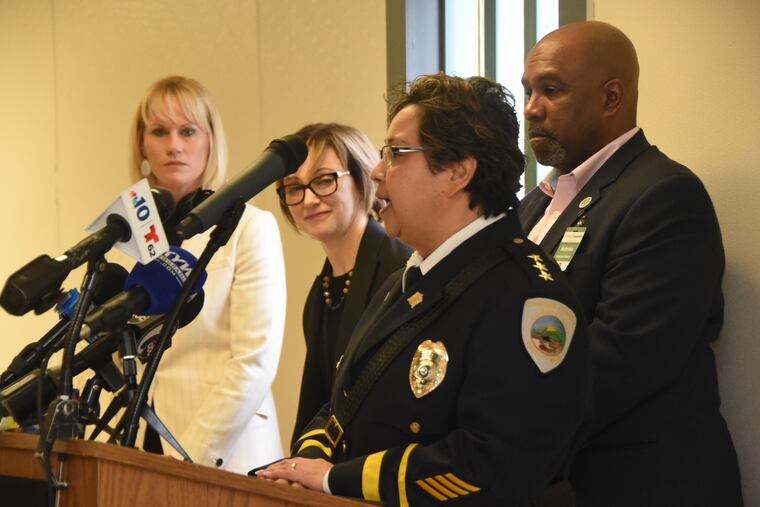Camden County Jail launches medication-assisted drug treatment program for inmates
Previously, the only option for the county’s inmates on opioids was to detox in jail -- even if they had been taking methadone, an opioid-based medication, in a treatment program.

The Camden County Jail is expanding a program to offer medication-assisted treatment — considered the gold standard for opioid addiction — to its inmates, officials announced Wednesday.
The new effort represents a shift in thinking at the jail, and is a change that’s been slow to take hold nationwide even as thousands continue to die from opioid overdoses. Camden’s jail will be the first in New Jersey to offer all three main forms of medication-assisted treatment, officials said. Along with Philadelphia’s jail system, it is one of fewer than two dozen in the country that offer the treatment drug buprenorphine to its inmates.
Until last summer, the only option for the vast majority of Camden inmates on opioids was to detox in jail, even if they had been in treatment using methadone, an opioid-based medication. Since June, inmates have been offered shots of naltrexone, known as Vivitrol, a widely marketed opioid blocker that unlike other treatment medicines does not contain opioids. However, it doesn’t have the track record of other medicines, and experts say it’s not effective for everyone at relieving cravings.
Two weeks ago, the jail began allowing inmates enrolled in methadone programs before their arrest to continue taking that treatment. Previously, only pregnant inmates were able to access a methadone program.
Last week, they began offering inmates Suboxone, a drug that combines the opioid buprenorphine with the overdose-reversing drug naloxone. Those treatments are paired with therapy, and inmates are referred to Project HOPE, a primary-care provider for Camden’s homeless, to continue treatment after their release.
The program is funded by a $200,000 grant from the state Department of Corrections.
Bureau of Justice statistics that suggest more than 60 percent of the country’s prison population is addicted to drugs or alcohol.
An estimated 329 people fatally overdosed in Camden County in 2018, up from 308 in 2017. And though it’s hard to track how many of those deaths occurred shortly after release from jail, people with addiction are uniquely at risk of overdose after a period of abstinence, whether that’s in jail or in detox. Opioid tolerance drops quickly, and many drug users overestimate how much they can handle after detoxing. And with the powerful opioid fentanyl tainting most of the area’s heroin supply, the risk of overdose is even higher.
“Where we are today and where we were 20 years ago — treatment [for people with addiction] was very, very low,” said David Owens, the county’s director of corrections, who also headed Philadelphia’s Department of Corrections, and then Pennsylvania’s, decades ago. “Making sure they got humane treatment was, at a time, beyond our expectation.”
Many wardens’ distaste for medication-assisted treatment centers around the idea of using an opioid to treat an opioid addiction — which has been misleadingly stigmatized as “trading one addiction for another.”
But, prescribed correctly, opioid-based medications, such as methadone and Suboxone, will not get a patient high, said Project HOPE’s medical director, Linda Bascelli. Most people deep in addiction are no longer using any opioids to feel a pleasurable high — they’re simply trying to avoid the intense pain of withdrawal so they can function normally.
The first time Bascelli told jail officials that they might want to offer their inmates medication-assisted treatment for opioid addiction, they laughed at her.
Ultimately, Camden’s warden, Karen Taylor, said she realized that her jail doubles as “sort of a triage,” with many inmates entering with serious chronic health issues, mental illnesses, and addictions.
“We have to treat the whole patient, and our job is to do less harm,” she said. “The numbers impacted me ... 630,000 people dying [of drug overdoses between 1999 and 2016 across the nation] impacted me.”
Many jail wardens are quicker to warm to Vivitrol, Taylor said, because it doesn’t contain an opioid. But Vivitrol requires a seven- to 10-day period of abstinence before a patient can begin taking it, and inmates in Camden’s jail often don’t have that kind of time. Many are in for only a few days. Suboxone, which can be administered within 12 to 36 hours of a patient’s entering withdrawal, could help more inmates get started on treatment, she said.
“We shouldn’t be the ones making decisions about what medication-assisted treatment to offer to individuals,” said Sharon Bean, the jail’s population manager.
Though giving inmates medication even during a short jail stay can help them maintain the tolerance they need to avoid overdose, officials say they want to help former inmates stick with their treatment program, a challenge they said they hope will become easier with the addition of the Suboxone program.
Forty-six inmates have been treated in the jail’s Vivitrol program since June, but only about seven have continued with treatment at Project HOPE. They include Jose Laguer, who got his first Vivitrol shot five months ago in the county jail and has been returning for monthly shots at Project HOPE ever since.
He said the drug — and group therapy — had helped curb cravings. And they’d protected him from turning to the fentanyl-tainted heroin on the street.
“With fentanyl, it’s not drugs out there no more — it’s death,” he said. “Before you go back out there, sign up for the Vivitrol shot.”